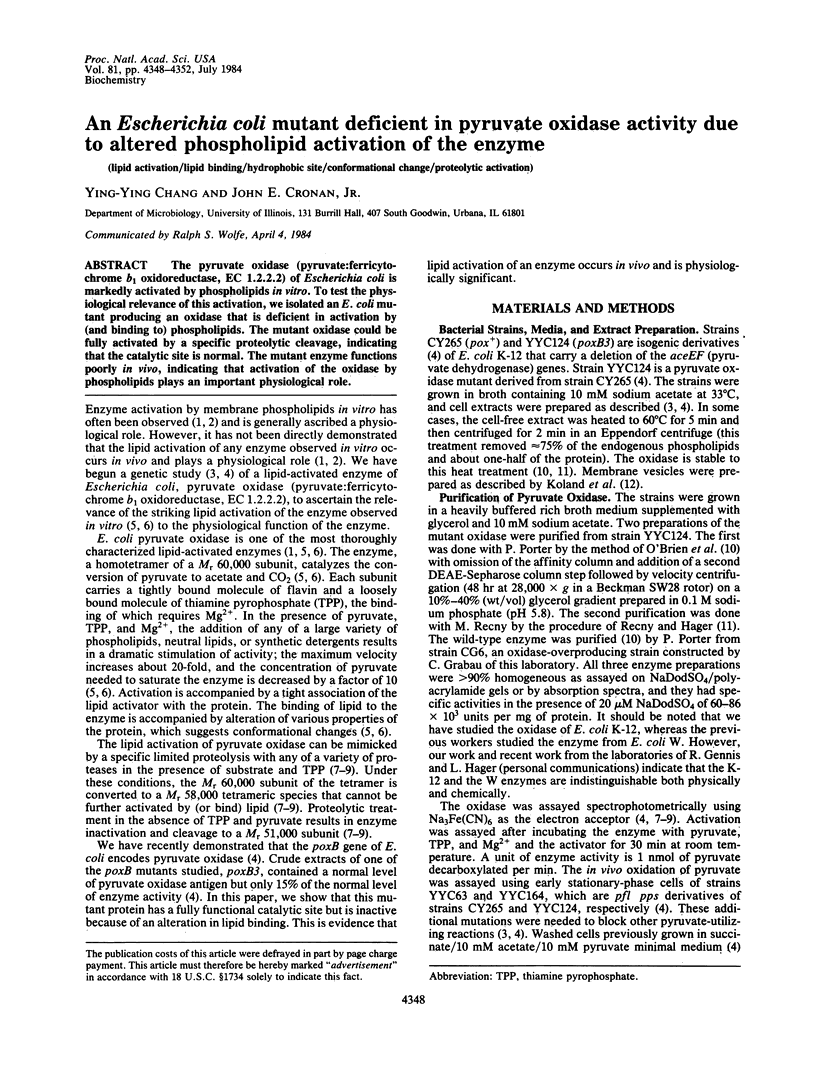Abstract
The pyruvate oxidase (pyruvate:ferricytochrome b1 oxidoreductase, EC 1.2.2.2) of Escherichia coli is markedly activated by phospholipids in vitro. To test the physiological relevance of this activation, we isolated an E. coli mutant producing an oxidase that is deficient in activation by (and binding to) phospholipids. The mutant oxidase could be fully activated by a specific proteolytic cleavage, indicating that the catalytic site is normal. The mutant enzyme functions poorly in vivo, indicating that activation of the oxidase by phospholipids plays an important physiological role.
Keywords: lipid activation, lipid binding, hydrophobic site, conformational change, proteolytic activation
Full text
PDF




Images in this article
Selected References
These references are in PubMed. This may not be the complete list of references from this article.
- Blake R., Hager L. P. Activation of pyruvate oxidase by monomeric and micellar amphiphiles. J Biol Chem. 1978 Mar 25;253(6):1963–1971. [PubMed] [Google Scholar]
- Burnette W. N. "Western blotting": electrophoretic transfer of proteins from sodium dodecyl sulfate--polyacrylamide gels to unmodified nitrocellulose and radiographic detection with antibody and radioiodinated protein A. Anal Biochem. 1981 Apr;112(2):195–203. doi: 10.1016/0003-2697(81)90281-5. [DOI] [PubMed] [Google Scholar]
- Chang Y. Y., Cronan J. E., Jr Genetic and biochemical analyses of Escherichia coli strains having a mutation in the structural gene (poxB) for pyruvate oxidase. J Bacteriol. 1983 May;154(2):756–762. doi: 10.1128/jb.154.2.756-762.1983. [DOI] [PMC free article] [PubMed] [Google Scholar]
- Chang Y. Y., Cronan J. E., Jr Mapping nonselectable genes of Escherichia coli by using transposon Tn10: location of a gene affecting pyruvate oxidase. J Bacteriol. 1982 Sep;151(3):1279–1289. doi: 10.1128/jb.151.3.1279-1289.1982. [DOI] [PMC free article] [PubMed] [Google Scholar]
- Cunningham C. C., Hager L. P. Crystalline pyruvate oxidase from Escherichia coli. II. Activation by phospholipids. J Biol Chem. 1971 Mar 25;246(6):1575–1582. [PubMed] [Google Scholar]
- Engelman D. M., Steitz T. A. The spontaneous insertion of proteins into and across membranes: the helical hairpin hypothesis. Cell. 1981 Feb;23(2):411–422. doi: 10.1016/0092-8674(81)90136-7. [DOI] [PubMed] [Google Scholar]
- Gennis R. B. Protein-lipid interactions. Annu Rev Biophys Bioeng. 1977;6:195–238. doi: 10.1146/annurev.bb.06.060177.001211. [DOI] [PubMed] [Google Scholar]
- Helenius A., McCaslin D. R., Fries E., Tanford C. Properties of detergents. Methods Enzymol. 1979;56:734–749. doi: 10.1016/0076-6879(79)56066-2. [DOI] [PubMed] [Google Scholar]
- Koland J. G., Miller M. J., Gennis R. B. Reconstitution of the membrane-bound, ubiquinone-dependent pyruvate oxidase respiratory chain of Escherichia coli with the cytochrome d terminal oxidase. Biochemistry. 1984 Jan 31;23(3):445–453. doi: 10.1021/bi00298a008. [DOI] [PubMed] [Google Scholar]
- Kyte J., Doolittle R. F. A simple method for displaying the hydropathic character of a protein. J Mol Biol. 1982 May 5;157(1):105–132. doi: 10.1016/0022-2836(82)90515-0. [DOI] [PubMed] [Google Scholar]
- Mather M., Blake R., Koland J., Schrock H., Russell P., O'Brien T., Hager L. P., Gennis R. B., O'Leary M. Escherichia coli pyruvate oxidase: interaction of a peripheral membrane protein with lipids. Biophys J. 1982 Jan;37(1):87–88. doi: 10.1016/S0006-3495(82)84613-4. [DOI] [PMC free article] [PubMed] [Google Scholar]
- O'Brien T. A., Schrock H. L., Russell P., Blake R., 2nd, Gennis R. B. Preparation of Escherichia coli pyruvate oxidase utilizing a thiamine pyrophosphate affinity column. Biochim Biophys Acta. 1976 Nov 8;452(1):13–29. doi: 10.1016/0005-2744(76)90054-1. [DOI] [PubMed] [Google Scholar]
- Recny M. A., Hager L. P. Isolation and characterization of the protease-activated form of pyruvate oxidase. Evidence for a conformational change in the environment of the flavin prosthetic group. J Biol Chem. 1983 Apr 25;258(8):5189–5195. [PubMed] [Google Scholar]
- Recny M. A., Hager L. P. Reconstitution of native Escherichia coli pyruvate oxidase from apoenzyme monomers and FAD. J Biol Chem. 1982 Nov 10;257(21):12878–12886. [PubMed] [Google Scholar]
- Russell P., Hager L. P., Gennis R. B. Characterization of the proteolytic activation of pyruvate oxidase. Control by specific ligands and by the flavin oxidation-reduction state. J Biol Chem. 1977 Nov 10;252(21):7877–7882. [PubMed] [Google Scholar]
- Russell P., Schrock H. L., Gennis R. B. Lipid activation and protease activation of pyruvate oxidase. Evidence suggesting a common site of interaction on the protein. J Biol Chem. 1977 Nov 10;252(21):7883–7887. [PubMed] [Google Scholar]
- Shaw-Goldstein L. A., Gennis R. B., Walsh C. Identification, localization, and function of the thiamin pyrophosphate and flavin adenine dinucleotide dependent pyruvate oxidase in isolated membrane vesicles of Escherichia coli B. Biochemistry. 1978 Dec 26;17(26):5605–5613. doi: 10.1021/bi00619a004. [DOI] [PubMed] [Google Scholar]
- von Heijne G. On the hydrophobic nature of signal sequences. Eur J Biochem. 1981 May 15;116(2):419–422. doi: 10.1111/j.1432-1033.1981.tb05351.x. [DOI] [PubMed] [Google Scholar]




